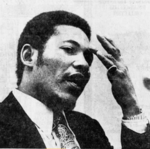 Chicago Sun-Times, September 23, 1977. Delbert Lee Tibbs, a 34-year-old black former seminary student from Chicago, was convicted by an all-white jury in Lee County, Florida, of the 1974 murder of Terry Robert Milroy, a 27-year-old white man, and the rape of Cynthia Nadeau, Milroy’s 17-year-old white girlfriend. Tibbs was sentenced to death for the murder and life in prison for the rape. The conviction rested primarily on Nadeau’s identification of Tibbs, corroborated by the testimony of Sylvester Gibbs, a convicted rapist and known perjurer who claimed that Tibbs had admitted the crime to him when the two were together in the Lee County Jail. Milroy and Nadeau were hitchhiking from St. Petersburg to Marathon on February 3, 1974, when they were picked up near Fort Myers by a black man who shot Milroy to death, raped Nadeau, and left her bleeding and unconscious beside a secluded road. Nadeau told police the man had a dark complexion and pockmarked skin. Three days later, Tibbs was hitchhiking near Ocala, some 220 miles north of Fort Myers, when he was stopped by police, questioned about the crime, and photographed. Because Tibbs did not fit Nadeau’s description—he had light skin and a smooth complexion—he was released. However, several photographs of him were sent to Fort Myers. From them, Nadeau made a “positive” identification. A warrant was issued, and Tibbs was arrested on March 13 in Clarksdale, Mississippi. He waived extradition and was taken to Fort Myers, where he was identified by Nadeau in a live lineup that included three other black men. On March 27, he was indicted by a Lee County grand jury for murder and rape. The trial opened on December 11, 1974. Tibbs, who had no criminal record, was represented by George Howard, a well-known Chicago lawyer who had entered the case at the behest of Tibbs’s brother Roy, a Cook County deputy sheriff. Lee County State Attorney James R. Long prosecuted the case. Long offered no physical evidence purporting to link Tibbs to the crime, relying solely on the testimony of Nadeau and Gibbs. On cross examination, Howard zeroed in on the discrepancy between Tibbs’s appearance and Nadeau’s initial description of the killer-rapist and elicited an admission from Gibbs that he had committed perjury at his own trial. Tibbs took the stand in his own defense, testifying that he had never been in Lee County—an assertion that was contradicted by no one except Nadeau. Howard also called several upstanding Chicagoans who knew Tibbs from his student days at the Chicago Theological Seminary and who portrayed him generally as a gentle, thoughtful man whose character had been beyond reproach. After closing statements on December 14, the jury deliberated less than ninety minutes before returning a verdict of guilty. Judge Thomas Sands sentenced Tibbs on March 24, 1975 to death in the Florida electric chair for the murder and life in prison for the rape. On July 28, 1976, the Florida Supreme Court reversed the conviction and remanded the case for a new trial based on the weight of the evidence. “[N]ot one shred of evidence was developed to place Tibbs in the Fort Myers area at any time,” said the state high court. Tibbs then challenged the state’s right to try him a second time, claiming that the prosecution was barred by the double jeopardy clause of the Fifth Amendment. Judge Jack Schoonover agreed that a retrial was barred and ordered Tibbs’s release on $90,000 bond. Roy Tibbs raised the bond money and, over the prosecution’s strenuous objection, Tibbs was released on January 8, 1977. Meanwhile, the prosecution appealed Schoonover’s double-jeopardy ruling, which was reversed on April 9, 1981 by the Florida Supreme Court, holding that because the verdict had been overturned on the weight of the evidence—as opposed to the sufficiency of the evidence—Tibbs could be retried. The U.S. Supreme Court affirmed that decision on June 7, 1982. By then, however, Gibbs had acknowledged that he had lied at the trial in the hope of receiving leniency in his own case and Nadeau had become a hardcore narcotics addict. On July 7, 1982, State Attorney Long’s successor, Joseph D’Allesandro, dropped the charges against Tibbs. Long then publicly acknowledged that the case had been “tainted from the beginning and the investigators knew it.” Had Tibbs been retried, Long said he gladly would have testified as a defense witness. Tibbs, who spent nearly three years behind bars and was in jeopardy of a retrial for another five and a half years, received no compensation for the ordeal he had endured. – Michael L. Radelet and Rob Warden
|